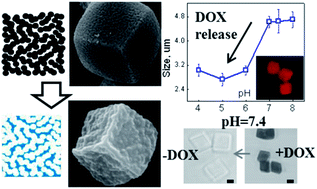pH-responsive hydrogel cubes for release of doxorubicin in cancer cells†
Abstract
We report on a novel type of shaped hydrogel microparticles which undergo large, rapid, and reversible volume changes in response to solution pH. The cubic hydrogels are produced as interconnected poly(methacrylic acid) (PMAA) network replicas of mesoporous manganese oxide templates by sequential infiltration of (PMAA) and poly(N-vinylpyrrolidone) (PVPON), followed by cross-linking of PMAA and template dissolution. The integrated advantages of the porous cubic sacrificial templates and responsive PMAA matrix enable synthesis of monodisperse and pH-sensitive hydrogel cubes in a rapid, facile, and reproducible manner. These hydrogel cubes display a reversible 2-fold change in size while maintaining their shape in response to pH variations. The swelling behavior of cubic and spherical hydrogel particles is controlled by the network structure which is regulated by the PMAA molecular weight. These networks maintain their three-dimensional shapes in the dry state. No cytotoxicity is found for cubic and spherical hydrogels upon their interactions with human cancer cells for various time intervals. Finally, pH-triggered loading and release of doxorubicin to and from the cubic hydrogels is shown and their anticancer effect is demonstrated. The viability of A549 and HeLa cancer cells was significantly decreased upon interaction with doxorubicin-loaded cubic hydrogels. The approach presented here provides a new platform of multi-functional particles with highly-controlled geometry, size, composition, and responsive properties to be potentially used in targeted drug delivery for cancer therapy.

- This article is part of the themed collection: Emerging Investigators

 Please wait while we load your content...
Please wait while we load your content...